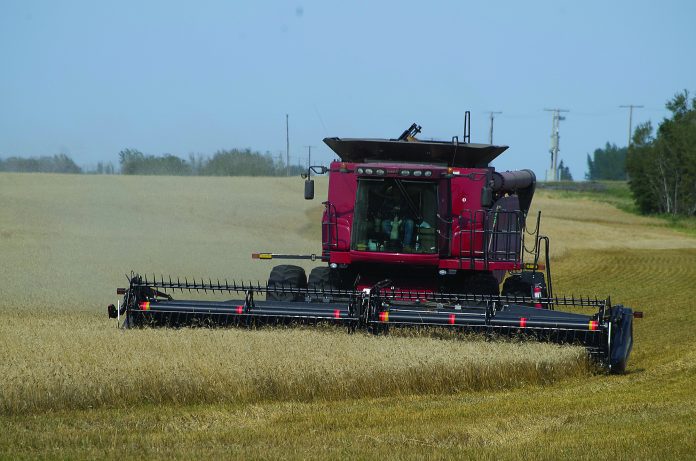
Ministry of Agriculture, Submitted
Producers continued to make progress harvesting their crops this week. Scattered rain helped with moisture levels as systems moved through the province. Saskatchewan is now 21 per cent completed harvest, ahead of the five-year average of 14 per cent and the 10-year average of 11 per cent.
The southwest continues to lead the province in harvest progress, with 38 per cent of the crop harvested. This is followed by the west-central, which has 27 per cent harvested so far. The northwest has received moisture these past few weeks and as a result only four per cent completed harvest.
Harvest progress advanced in all crops this week. Fall cereals continue to lead the crops being harvested; 89 per cent of fall rye and 74 per cent of winter wheat crops are harvested. Field peas and lentils continue to lead the spring-seeded crops in harvest progress; 66 per cent of field peas and 60 per cent of lentils are harvested. Barley leads the spring seeded cereals, with 30 per cent of the crop harvested. With 27 per cent of crop in the bin, mustard leads oilseed harvest progress, ahead of canola and flax.
All crop districts received rain as scattered moisture moved through the province again this week. The most rain reported was 59 mm in the Barthel area. The Cabri area in the southwest also received significant moisture, with 52 mm reported. The scattered showers resulted in an increase in topsoil moisture across the province. Thirty-two per cent of crop land has adequate moisture, 41 per cent is short and 27 per cent is very short. In hay and pastures, 24 per cent have adequate moisture, 42 per cent are short and 34 per cent are very short.
Pasture conditions in the province have improved with the recent moisture. Twelve per cent of pastures are in good condition, 29 per cent are fair, 40 per cent are poor and 19 per cent are very poor. Nine per cent of forage acres did not get cut or baled this year due to drought conditions.
Crop damage this past week was due to wind, localized flooding, drought, grasshoppers and gophers. Producers are also noting aster yellows in crops this week. Producers are busy combining, desiccating crops to encourage dry-down and monitoring moisture levels. Many are also busy hauling water for their animals and moving livestock.
Harvest is a very busy and stressful time for producers, and they are reminded to take safety precautions in all the work they do. This includes having fire mitigation resources at the ready and taking precautions when working around powerlines. The Farm Stress Line is available to provide support to producers toll free at 1-800-667-4442. The public is reminded to use extra caution when encountering machinery on the roads, and to give extra time and space.
Northeastern Saskatchewan
Producers in the northeast have made progress with harvest this week, and are now eight per cent complete harvest, this is ahead of the five-year average of seven per cent.
Producers have focused on getting their fall cereals off and have completed harvesting fall rye (100 per cent) and winter wheat (100 per cent). Producers have turned their focus to barley and have 21 per cent of that crop in the bin for the year. Field peas (45 per cent) and lentils (33 per cent) are the main pulses being harvested. Little progress has been made in oilseeds this week.
Scattered showers moved through the region this week. The Humboldt area recorded the most rainfall, with 33 mm being reported. The area has the best soil moisture in the province currently. Three per cent of cropland has a surplus of topsoil moisture, 69 per cent has adequate moisture, 25 per cent is short while three per cent is very short. Hay and pastureland are similar; one per cent has as surplus of moisture, 58 per cent is adequate, 39 per cent is short, and two per cent is very short.
Pastures in the region are in good (34 per cent) to fair (56 per cent) condition. Eleven per cent of forage acres went uncut or baled for the year due to weather related conditions.
Crop damage this past week is due to localized flooding and grasshoppers. Producers are busy monitoring moisture levels in standing crops, desiccating and combining. Producers are also working and moving livestock.
Northwestern Saskatchewan
The northwest has now completed five per cent of harvest, ahead of the five-year average of four per cent. Producers in the northwest are monitoring the moisture in their crops in the hopes of getting into the combines again soon.
Fall rye is the most harvested crop, with 94 per cent of the crop in the bin for the year. Producers are also harvesting barley, with seven per cent in the bin for the year. Field peas are 45 per cent complete, and lentils are 70 per cent harvested as well. Very few oilseeds have been harvested yet.
Rain continued to move into the region in scattered showers this week, with the Barthel region receiving 59 mm. Topsoil moisture continues to increase with the rain. Forty-three per cent of cropland has adequate moisture, 42 per cent is short, and 15 per cent is very short. Thirty-eight per cent of hay and pastures have adequate topsoil moisture, 44 per cent is short, and 18 per cent is very short.
Pastures are in fair (33 per cent) to poor (40 per cent) condition. The majority of forage acres were cut or baled this year, with only two per cent of acres going unharvested due to drought.
Crop damage this past week is due to excess moisture and grasshoppers. Producers are busy desiccating crops and monitoring crop maturity. Producers are also noting geese beginning to fly south for the winter.

